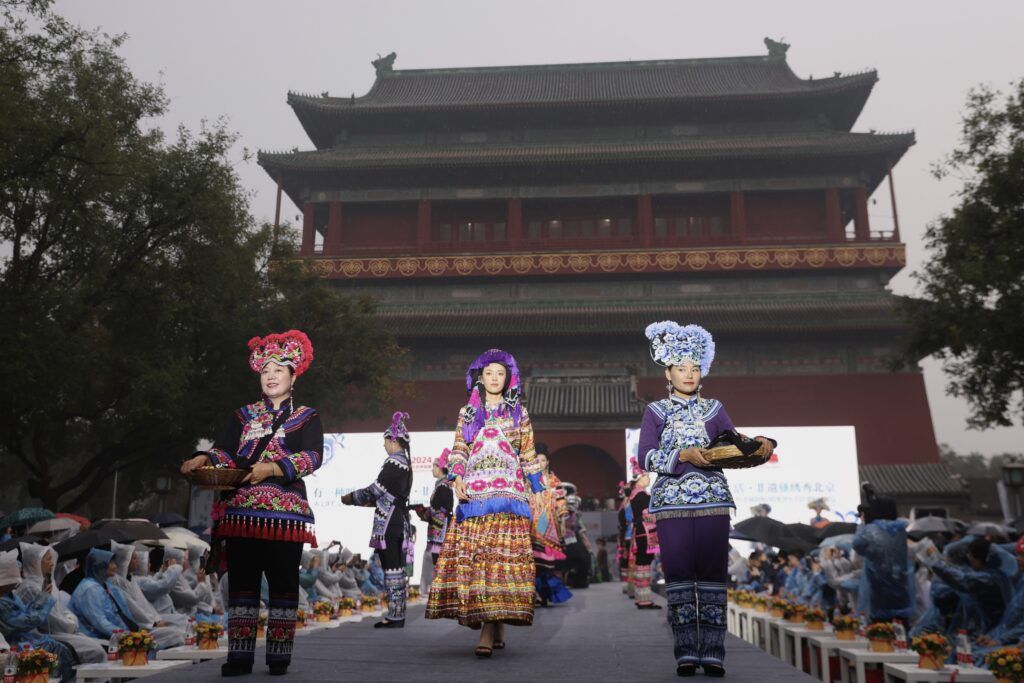
Last Sunday, a variety of traditional costumes designed by Yi ethnic creators from the Chuxiong Yi Autonomous Prefecture, in Yunnan province, were presented at the fashion show at the Bell and Drum Towers in Beijing.
The clothing line combines Yi embroidery and green peacock-inspired designs. This collection was a huge success when it was presented at Paris Fashion Week earlier this year. The traditional clothing-making techniques of the Chuxiong Yi ethnic group used in the creation of the garments have a history exceeding 1,700 years and were included as national intangible cultural heritage in 2014.
The Yi, an ethnic group of Austroasiatic origin, live mostly in the mountains of southwestern China and speak a Tibeto-Burman language.
At the beginning of the 21st century, the Yi population exceeded 7.5 million people. Its main concentrations are in Yunnan and Sichuan provinces, with smaller communities in the northwest of Guizhou province and in the northern part of the Guangxi Zhuang Autonomous Region. Nearly two-thirds of the Yi live in Yunnan province. Their language is spoken in six different dialects.
Among the most characteristic elements of traditional Yi culture we can mention agriculture based on the use of hoes, cattle breeding and hunting.
In the past, a caste system divided the Yi into three groups: the Black Bone Yi, the dominant group, who apparently descended from a people originating in northwest China; the White Bone Yi, much more numerous; and the Jianu, who were slaves of the Black Bone. The subjugation of the White Bone and Jianu ended in the 1950s by the Chinese government. Today, the White Bone Yi are distributed throughout the highlands of Yunnan and Guizhou, while the Black Bone Yi have their heartland in the Liang Mountains, southwest of the Sichuan Basin.
This ethnic group is well known thanks to its mastery in arts and crafts, such as lacquer painting, embroidery, goldsmithing and carving.
Yi embroidery, in particular, holds a very important place in their culture and is taught to girls from childhood. Skill in embroidery is so valued in the community that, in times past, a young woman with little skill in this technique could have difficulty finding a husband, regardless of her beauty.

At the fashion show in Beijing, designers were inspired by the green peacock, an important cultural symbol in the Yunnan region. The proposal was to merge traditional elements with a contemporary style that managed to capture the attention of experts and the general public. This collection had already received international praise previously, at Paris Fashion Week.
The Yi ethnic group celebrates several interesting festivals throughout the year. The most important are the so-called “Year of the tenth month” and the “Festival of Torches.”
The “Year of the Tenth Month” is celebrated on the most auspicious day within the first ten days of each tenth lunar month and lasts for five to six days. During this festival, the Yi community dresses in their best, most elaborate and beautiful costumes and visits their family and friends, bringing gifts to share.
On the other hand, the “Torch Festival”, which takes place on the 24th day of the sixth lunar month, is one of the most ceremonious. The celebration includes cattle sacrifices and celebrations that culminate with a large bonfire where the community gathers to dance and sing.

Traditional Yi clothing varies by region and dialect, but in general, Yi women wear embroidered clothing, accompanied by black headdresses and silver jewelry.
The spinsters can be identified by their colorful cockscomb-shaped hats, adorned with large amounts of silver ornaments.
Yi men, for their part, usually wear knee-length sheepskin cloaks and the hero’s knot. This is a type of hairstyle that symbolizes the dignity and indomitable spirit that characterizes the Yi population.

Source: https://reporteasia.com/cultura/2024/10/15/desfile-moda-beijing-celebra-cultura-etnia-yi/

